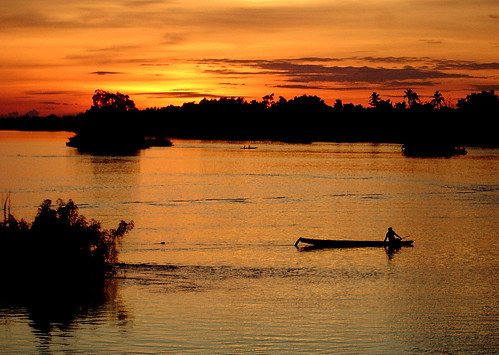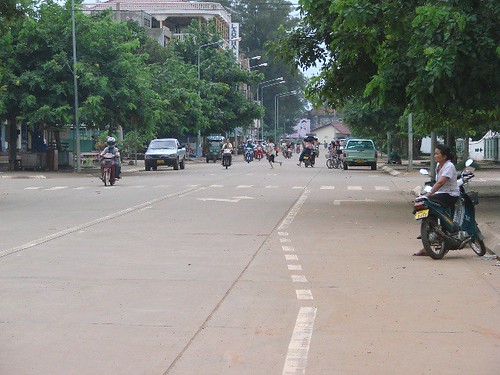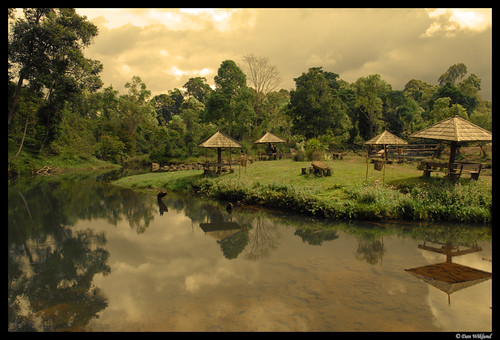Champasak: Laos’s New Destination !
samakomlao
|
Sunday, July 06, 2008
|
1 comment

When Laos began to truly open to tourism in the early 1990’s, visitors focused on the cultural riches of Luang Prabang in the north, and the southern regions remained for a long time a destination for the more adventurous travelers. But this is changing fast. With the remarkable improvement of road networks around the whole of Indochina, Champasak has become the center of a new buoyant backpacking scene commuting overland in luxurious sleeper buses between Vientiane and Phnom Penh. And with a bridge crossing over the Mekong that links Thailand and Vietnam along the east-west axis, getting across borders is now much easier.
Sand Bar Islands

Mention visiting an island in Laos and one will most likely meet with a perplexed gaze. The very idea of islands in Southeast Asia is so indubitably linked to visions of white sandy beaches, that it simply cannot fit Laos, a largely mountainous country with no direct access to the sea. But rivers too can harbour islands, and in the case of Laos, one has to take into account that the Mekong isn’t just any ordinary river. It is one of the longest rivers in the world, and the possibility of it giving rise to islands shouldn’t be regarded as impossible. However, the Lao name Si Phan Don, or Four Thousand Islands, that was bestowed on the lush and scenic Champasak province in Southernmost Laos is a little superlative, if not far-fetched. To meet with such an incredible number of islands, one has to take into account every single sand bar that emerges out at the peak of the dry season. That said, there are indeed a good number of islands inhabited all year round, the largest of which, Don Khone, measures no less than four-by-eight kilometers. At the height of the rainy season, some parts of the Mekong in Si Phan Don can span over 12 kilometers. This is also where the river suddenly drops in altitude, resulting in the formation of a few majestic waterfalls that have prevented thorough commercial use of the Mekong. One of these waterfalls, Khon Pha Pheng, is purpotedly the largest waterfall in Southeast Asia and, indeed, the impressive tumultuous flow of water stands as a stark reminder that the Mekong is also the 12th largest river of the world by volume.
The Two Dons
The islands of Si Phan Don are best explored by bicycle, cycling on sandy shaded paths across the forests or along the luxuriant river banks. Most activity takes place on the twin islands of Don Det and Don Khone, which are linked by a concrete bridge. This bridge was part of a train track built by the French to link Don Khone’s southernmost point and Don Det’s northern bank in an attempt to bypass the waterfalls and allow the transportation of goods on the Mekong. A short distance away from the bridge lies a rusting tiny locomotive that for many years commuted along the only railway track ever built in Laos. Don Det has attracted the younger segment of the backpacking scene, bringing a distinct hippy flavor to the place. Typical accommodations here take the form of hammocks hanging in the bungalows veranda, with a view over the river of course. The more comfortable accommodations are found in Don Khone. An interesting option is Sala Phae (Ban Khone Tai, Khong District, Champassak Province, +856-30-525 6390, +856-21-217 526, www. salaphae.salalao.com), which has floating raft rooms, where you can sleep in a large breezy room directly over the flow of the mighty river, watch the sunset from the veranda, and dip your feet in the cool water of the Mekong.
Pakse Crossroads

Si Phan Don, however, is only one of the many attractions that Champasak has to offer. The once sleepy little town of Pakse is right in the middle of the Indochina backpacker trail, and seems bent on becoming an important crossroad. In fact, judging by the number of luxury hotels under construction around town, Pakse has already become an attractive destination for a number of investors. Pakse too has its fair share of quaint colonial buildings from the turn of the 20th century which are an interesting combination of Art Deco and 1950’s architecture. Particularly arresting is a block of shophouses where one can see a clear chronological evolution of urban Southeast Asian architecture over the entire 20th century, from French colonial to 1990’s Post-Modern and Neo-Classical styles. And, with a scenic location at the confluence of the Mekong and the Se Don River, Pakse is actually quite a pleasant place to visit.
The Bolaven Plateau

Just one hour north of Pakse, with an altitude of around 1,000 meters, the Bolaven plateau was put to good use by French planters to cultivate coffee and tea. Today, a large quantity of the production is exported, and is one of Laos’s most important sources of foreign trade. This is the place to find cool air and nature at its best. Ecotourism has become a catch word in Laos, heavily encouraged by local authorities, and the Bolaven plateau has a lot to offer. You can enjoy scenic rides across forests, coffee and tea plantations; hop from one pretty waterfall to the next, stop in hill tribe villages to buy intricate hand-woven textiles or take the obligatory elephant ride. More adventurous travelers can rent motorbikes to explore the plateau on their own. The Bolaven plateau also has a few atmospheric accommodation options to offer in the form of bungalows overlooking cool waterfalls.
The Ruins of Wat Phu

Champasak is home to one of the oldest Khmer sites in existence—the ruins of Wat Phu. The origin of this temple is found in the shape of the mountain at the foot of which the temple started taking shape in the fifth century CE. The summit, the Phu Kao, immediately commands ones attention because of its resemblance to a linga, Shiva’s phallic symbol. Phu Kao was believed to be a natural linga, a spontaneous manifestation of the Hindu god. At the foot of the mountain, fl owed a spring, around which the temple was built. Later in history, that spring was used to keep the linga of the sanctuary perpetually wet, a set-up apparently unique to the Khmer world. Wat Phu presents fine examples of Khmer sculpture and is best visited in the early morning when the frangipanis lining the staircase leading to the sanctuary pervade the air with their heavenly smell. In order to be there in time for sunrise, it is best to stay in the nearby little town of Champasak that gives its name to the province, which was previously the capital of a short-lived, 18th century kingdom that has lost most of its former glory. There are a few guesthouses of fairly good standard. The best and most romantic option is La Folie Lodge (Don Daeng, District Pathoumphone, BP 668, Champassak, Lao PDR., 856-534-7603, reservations@folie-laos.com), a resort complete with swimming pool overlooking the Mekong and finely decorated teak bungalows set in the lush greenery of the island of Don Daeng. As the whole of Indochine opens up ever more to tourism, there will be fewer and fewer places like Champasak left to explore. Go now.
Source: AziaCity.com
Filed Under: 000 islands , 4 , Champasak province , dolphin , information , information visa , Laos luang prabang , laotian tourism , Luang prabang Pakse , South , tourist

amazing...